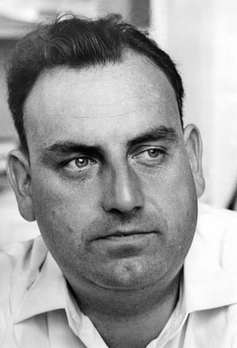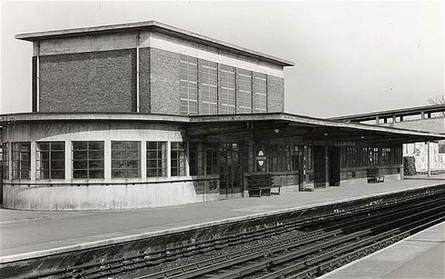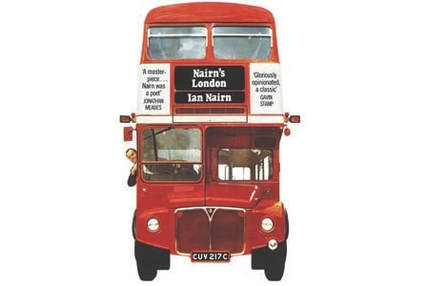|
Ian Nairn was a critic, writer and broadcaster who critiqued post war design and planning from the 1950’s until his premature death in 1983. Despite a lack of architectural education, Nairn, who served in the RAF just after World War II, managed to finagle a job with the Architectural Review magazine in 1955. He came to prominence, in public as well as architectural circles, with his withering denunciation of the failures of post war planning, Outrage, in which he coined the term Subtopia. Subtopia defined the messy, suburban sprawl that gathers around cities and towns as they expand and change, as the urban invades the rural. As well as working on Sir Nikolaus Pevsner’s Buildings of England series, where he was let go due to his overly subjective style, he penned the books Nairn's’ London (1966) and Modern Buildings in London (1964), both equally cherished today as they were on publication. It is from these books that we will look at Ian Nairn's opinions on Metro-Land and its buildings. Nairn’s London ranges all over the Greater London region, “A record of what has moved me between Uxbridge and Dagenham” as Nairn says in the introduction. Like Sir John Betjeman in his Metro-Land film of 1973, Nairn’s first stop in Metro-Land is at Wembley and the ruins of the 1924 British Empire Exhibition. Now almost all gone, at the time of writing Nairn’s London, many of the exhibition buildings remained, unlike those of the Festival of Britain only 15 years previous. Nairn praises the “bull-nosed” concrete buildings, then used as warehouses and business premises. He notes a concrete bridge mouldering away “among weeping willows and beer cans”, and calls it “one of the best things we did in the twenties...true English modernism”. Now long gone, presumably it is the bridge pictured below, most probably designed by Owen Williams. In his Wembley wanderings he also mentions The Torch pub, calling it “as good as anywhere in London to feel the real temper of the ‘ordinary England’ in the 1960’s”. The pub is still there, filled with football fans on weekends. Again, like Betjeman, his next stop of interest is Ernest Trobridge’s medieval fantasy houses in Kingsbury. Also like Betjeman, Nairn doesn't mention the architect by name, presumably he was so out of fashion in the mid-1960’s his name had been forgotten. Nairn praises the houses, saying they are “a real expression of the dreams of individuality which sent people flocking here in the 1920’s along with the Underground”. This is very much representative of Nairn’s tone throughout the two books; against planners, out of touch architects and bureaucrats and for the man in the street. Nairn gives short shrift to some of the other Metro-Land towns; Harrow “swamps its village with Victorian buildings as ponderous as company reports”, and in Watford Nairn calls the new High Street “despicable” and the post war office blocks “just about bearable”. Whereas Nairn’s London is interested in a sense of place as well as buildings, Modern Buildings in London is a more straight architectural guidebook, produced for London Transport. In it he praises Charles Holden’s work for London Underground from the early 1930’s as well as criticising the later works. Arnos Grove is described as one of the first modernist buildings in Britain “that did not throw their style in the public’s face”. In the entry for Sudbury Town, Nairn laments that Holden would “decline into frivolities and...weary classicisms..” after his early London Underground work. His later station at Uxbridge, designed with L.H. Bucknell, comes in for criticism, saying that exterior facade “just about ruins the centre of Uxbridge”, before praising the interior, calling it “one of Holden’s most luminous inventions”. Nairn is never one for choosing the obvious to praise, indeed he seems to prefer criticising the more famous buildings of the era. Instead he often praises projects which are now forgotten in obscurity. In both Nairn’s London and Modern Buildings in London, he includes Mansfield Heights (1956), a small scheme of Metropolitan Police housing in East Finchley. The mini estate is still there, now presumably privately owned, with houses and two small blocks of flats, and some small scale landscaped gardens. A similar and nearby scheme noted by Nairn is Green Bank in Woodside Park (1961). Designed by Ronald Salmon & Partners, Nairn calls them “fresh, straightforward terraces” and presciently notes that scheme’s impact rests on its maintenance which “will need watching”. As we know, many modernist schemes of the 1950’s & 60’s looked fine on the drawing board and publicity photos but would later succumb to neglect and decay. Some of the buildings Nairn highlighted are no longer with us. Alexander Gibson’s house at 5 Cannon, Hampstead (1955) featured in a number of architectural books of the era. Nairn praised it for being “Small, simple and beautifully detailed”. Unfortunately the house was demolished in 2010 and replaced by another design by Claudio Silvestrin. In Uxbridge, Nairn noted the Imhof Factory (1957) by Tayler & Green, known for their housing work in Norfolk. Nairn calls it a “sophisticated, arcadian building” and laments that New Town factories were designed with the same quality. Again this building was demolished at the start of the 21st century. Ian Nairn continued to range all over Britain, Europe and the United States producing books and television series, such as Britain's Changing Towns, Nairn’s Paris and Nairn at Large. Unfortunately Nairn would slide into alcoholism in his later years. He had always been a huge beer drinker, ( Nairn’s London even has a Beer section in the back of he book), but as he got older the work thinned out and the drinking increased. Nairn died 14 August 1983 at the age of 52, of cirrhosis of the liver. In recent years his influence and writings have received much more attention, with reissues of some of his books, including Nairn's London and Britain’s Changing Towns, as well as a BBC4 documentary about him. In an age of “Icon” architecture and ever increasing Subtopia between town and city, Nairn’s warnings about the desecration of our public spaces is one to heed. Ian Nairn’s book were a great inspiration in starting this site, and we hope to produce our own “ A Guide to Modernism in Metro-Land”, a guide to the art deco and modernist buildings of the region. Follow this link to help make this possible and see the great rewards for pledging Pledge for A Guide to Modernism in Metro-Land
0 Comments
Leave a Reply. |
Archives
May 2024
Categories |






 RSS Feed
RSS Feed